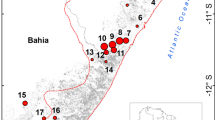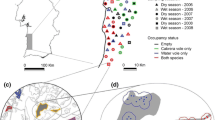Abstract
Analysis of population variations in space and time suggests that landscape may act as a substrate for several kinds of interactions: neighborhood effects, edge effects, prey-predator and parasite-host relationships, etc. Here we discuss how landscape structure and physiognomy affect vole population dynamics. We present the results of a six-year survey of vole populations in the Jura mountains of eastern France (700–900 m elev.) which was conducted to determine whether patch array (i.e. spatial arrangement of different habitat patches) and vole demography are interconnected?
The population kinetics of M. arvalis has been monitored in different habitats characterized by extensive homogenous and heterogeneous landscapes. We compare results from different parts of these landscapes to test the neighborhood effects of hedgerow networks, wood mosaics, forests, and villages. Analysis suggests that (1) refuge habitats for specialist predators act as destabilizing factors increasing both the amplitude of fluctuations and the duration of the high density phase, (2) refuge habitats for generalist predators act as regulating factors, dampening vole population kinetics and shortening the phase of peak numbers, (3) sink effects occur at forest edges and in the vicinity of villages, and (4) barrier effects are detected in grassland surrounded by forest. Such descriptive studies have implications for pest control strategies and provide a framework for further demographic field studies and natural experiments.
Similar content being viewed by others
References
Andersson, M. and Erlinge, S. 1977. Influence of predation on rodent populations. Oikos 29: 591–597.
Andrén, H. 1994. Effects of habitat fragmentation on birds and mammals in landscapes with different proportions of suitable habitat: a review. Oikos 71: 355–366.
Barrett, G.W. and Peles, J.D. 1994. Optimizing habitat fragmentation; an agrolandscape perspective. Landscape Urban Planning 28: 99–105.
Batzli, G.O. 1994. Community responses of voles to patchy habitats. Polish Ecol. Studies 20: 85–99.
Bowers, A.M. and Dooley, J.L. 1998. A controlled, hierarchical study of habitat fragmentation: responses at the individual, patch, and landscape scale. Landscape Ecology, in press.
Butet, A. and Leroux, A. 1994. Spatial and temporal density in common vole populations in a marsh in western France. Polish Ecol. Studies 20: 137–146.
Chambers, L.K., Singleton, G.R. and Van Wensveen, M. 1996. Spatial heterogeneity in wild populations of house mice (Mus domesticus) on the Darling Downs, south-eastern Queensland. Wildlife Res. 23: 23–38.
Delattre, P., Giraudoux, P., Damange, J.P. and Quéré, J.P. 1990. Recherche d'un indicateur de la cinétique démographique des populations du campagnol des champs (Microtus arvalis). Revue Ecologie (Terre et Vie) 45: 375–384.
Delattre, P., Giraudoux, P., Baudry, J., Musard, P., Toussaint, M., Truchetet, D., Stahl, P., Lazarine-Poule, M., Artois, M., Damange, J.P. and Quéré, J.P. 1992a. Land use patterns and types of common vole (Microtus arvalis) population kinetics. Agriculture, Ecosyst. Env. 39: 153–169.
Delattre, P., Giraudoux, P., Habert, M. and Quéré, J.P. 1992b. La lutte contre les rongeurs en plantations de feuillus. Application des techniques de lutte intégrée. Revue Française Forestière 44: 91–98.
Delattre, P., Giraudoux, P., Baudry, J., Quéré, J.P. and Fichet, E. 1996. Effect of landscape structure on Common Vole (Microtus arvalis) distribution and abundance at several space scales. Landscape Ecol. 11: 279–288.
Erlinge, S., Göransson, G., Hansson, L., Högstedt, G., Liberg, O., Nilsson, I.N., Nilsson, T., Von Schantz, T. and Sylvén, M. 1983. Predation as a regulating factor on small rodent populations in southern Sweden. Oikos 40: 36–52.
Fahrig, L. 1992. Relative importance of spatial and temporal scales in a patchy environment. Theor. Popul. Biol. 41: 300–314.
Fitzgerald, B.M. 1977. Weasel predation on a cyclic population of the montane vole (Microtus montanus) in California. J. Animal Ecol. 46: 367–397.
Gaines, M.S., Diffendorfer, J.E., Foster, J., Wray, F.P. and Holt, R.D. 1994. The effect of habitat fragmentation on populations of three species of small mammals in Eastern Kansas. Polish Ecol. Studies 20: 163–175.
Giraudoux, P., Delattre, P., Habert, M., Quéré, J.P., Deblay, S., Defaut, R., Duhamel, R., Moissenet, M.F., Salvi, D. and Truchetet, D. 1997. Population dynamics of the fossorial form of the water vole (Arvicola terrestris Scherman): a land usage and landscape perpective. Agriculture Ecosyst. Env. 66: 47–60.
Hanski, I. 1987. Populations of small mammals cycle-unless they don't. Trends Ecol. Evol. 2: 55–56.
Hanski, I., Hansson, L. and Henttonen, H. 1991. Specialist predators, generalist predators, and the microtine rodent cycle. J. Animal Ecol. 60: 353–367.
Hansson, L. 1988. The domestic cat as a possible modifier of vole dynamics. Mammalia 52: 159–164.
Hansson, L. 1989. Predation in heterogeneous landscapes: how to evaluate total impact? Oikos 54: 117–119.
Hansson, L. 1990. Spatial dynamics in fluctuating vole populations. Oecologia 85: 213–217.
Hansson, L. 1994. Verterbrate distributions relative to clear-cut edges in a boreal forest landscape. Landscape Ecol. 9: 105–115.
Hansson, L. 1995. Development and application of landscape approaches in mammalian ecology. In Landscape Approaches in Mammalian Ecology and Conservation. pp. 20–39. Edited by W.Z. Lidicker, Jr. University of Minesota Press, Minneapolis.
Henttonen, H. 1986. Causes and geographic patterns of microtine cycle. Ph. D. Thesis, Department of Zoology, University of Helsinki.
Henttonen, H., Oksanen, T., Jortikka, A. and Haukisalmi, V. 1987. How much do weasels shape microtine cycles in the northern Fennoscandia taiga? Oikos 50: 353–365.
Heske, E.J. 1998. Activity of generalist mammalian predators and songbird nest predation on forest-field edges in east-central Illinois. Landscape Ecol., in press.
Lidicker, W.Z., Jr. 1988. Solving the enigma of microtine ‘cycles'. J. Mammal. 69: 225–235.
Lidicker, W.Z., Jr. 1991. In defense of a multifactor perspective in population ecology. J. Mammal. 72: 631–635.
Lidicker, W.Z., Jr. 1994. A spatially explicit approach to vole population processes. Polish Ecol. Studies 20: 215–225.
Lidicker, W.Z., Jr. 1995. The landscape concept: something old, something new. In Landscape Approches in Mammalian Ecology and Conservation. pp. 3–19. Edited by W.Z. Lidicker, Jr. University of Minnesota Press, Minneapolis.
Liro, A. and Szacki, J. 1994. Movements of small mammals along two ecological corridors in suburban Warsaw. Polish Ecol. Studies 20: 227–231.
Loman, J. 1991. Small mammal and raptor densities in habitat islands; area effect in a south Swedish agricultural landscape. Landscape Ecology 5: 183–189.
Ostfeld, R.S. 1992. Effect of habitat patchiness on population dynamics: a modelling approach. In Wildlife 2001: Populations. pp. 851–863. Edited by D.R. McCullough and R.H. Barrett. Elsevier Applied Science, London.
Pulliam, H.R. 1988. Sources, sinks, and population regulation. Am. Nat. 132: 652–661.
Readhead, T.D. and Singleton, G.R. 1988. The PICA Strategy for the prevention of losses caused by plagues of Mus domesticus in rural Australia. EPPO Bull. 18: 237–248.
Szacki, J., Babinska-Werka, J. and Liro, A. 1993. The influence of landscape spatial structure on small mammal movements. Acta Theriologica 38: 113–123.
Teivainen, T. 1979. Vole damage to forest tree seedlings in reforested areas and fields in Finland in the years 1973–1976. Folia Forestalia 387: 1–25.
Turner, M.G. and Gardner, R.H. (eds) 1991. Quantitative methods in landscape ecology. Springer-Verlag, New York.
Wiens, J.A., Stenseth, N.C., Van Horne, B. and Ims, R.A. 1993. Ecological mechanisms and landscape ecology. Oikos 66: 369–380.
Author information
Authors and Affiliations
Rights and permissions
About this article
Cite this article
Delattre, P., De Sousa, B., Fichet-Calvet, E. et al. Vole outbreaks in a landscape context: evidence from a six year study of Microtus arvalis. Landscape Ecology 14, 401–412 (1999). https://doi.org/10.1023/A:1008022727025
Issue Date:
DOI: https://doi.org/10.1023/A:1008022727025




